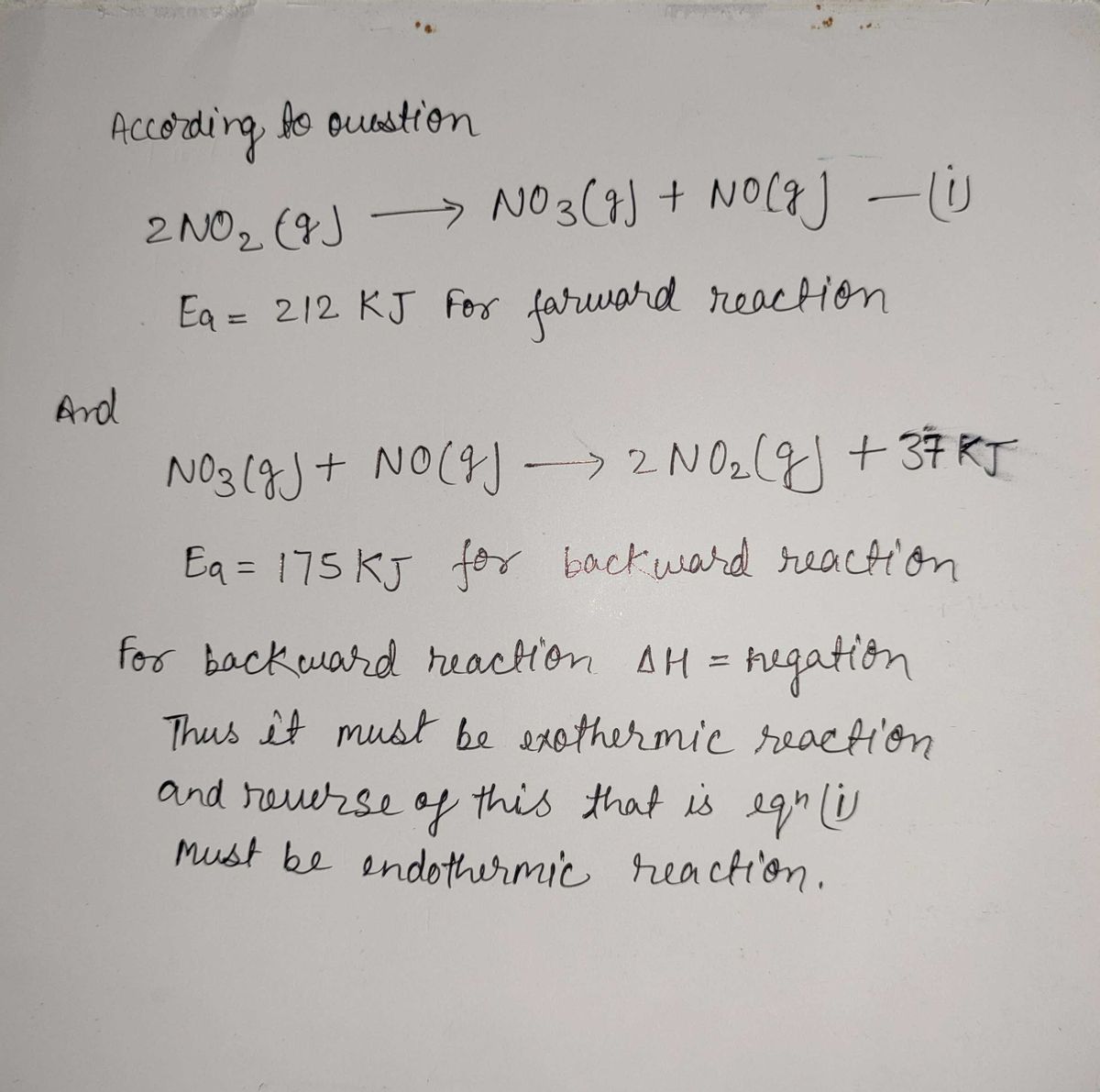Consider the reaction: 2 NO2 (g) → NO3 (g) + NO (g) with 2-mol NO2 (9) transformed into 1-mol NO3 (g) and 1-mol NO (g). At 380 K, the activation energy of the forward reaction is 212 kJ, and the activation energy of the reverse reaction is 175 kJ. Based on the information given here, which of the following statements is correct? By increasing the concentration of NO2, the rate constant of the forward reaction increases. O b. The forward reaction of this reaction is an endothermic reaction. By adding a catalyst to speed up the reaction, the activation energy of the reverse reaction decreases and the activation energy of the forward reaction stays the same. By adding a catalyst to speed up the reaction, the activation energy of the forward reaction decreases and the activation energy of the reverse reaction stays the same. O e. The reverse reaction of this reaction is an endothermic reaction.
Consider the reaction: 2 NO2 (g) → NO3 (g) + NO (g) with 2-mol NO2 (9) transformed into 1-mol NO3 (g) and 1-mol NO (g). At 380 K, the activation energy of the forward reaction is 212 kJ, and the activation energy of the reverse reaction is 175 kJ. Based on the information given here, which of the following statements is correct? By increasing the concentration of NO2, the rate constant of the forward reaction increases. O b. The forward reaction of this reaction is an endothermic reaction. By adding a catalyst to speed up the reaction, the activation energy of the reverse reaction decreases and the activation energy of the forward reaction stays the same. By adding a catalyst to speed up the reaction, the activation energy of the forward reaction decreases and the activation energy of the reverse reaction stays the same. O e. The reverse reaction of this reaction is an endothermic reaction.
Chemistry
10th Edition
ISBN:9781305957404
Author:Steven S. Zumdahl, Susan A. Zumdahl, Donald J. DeCoste
Publisher:Steven S. Zumdahl, Susan A. Zumdahl, Donald J. DeCoste
Chapter1: Chemical Foundations
Section: Chapter Questions
Problem 1RQ: Define and explain the differences between the following terms. a. law and theory b. theory and...
Related questions
Question
100%
Please help:
![**Chemical Reaction Analysis**
Consider the reaction:
\[ 2 \text{NO}_2 \, (g) \rightarrow \text{NO}_3 \, (g) + \text{NO} \, (g) \]
This reaction entails the transformation of 2 moles of \(\text{NO}_2\) gas into 1 mole of \(\text{NO}_3\) gas and 1 mole of \(\text{NO}\) gas.
At 380 K, the activation energy for the forward reaction is 212 kJ, while the activation energy for the reverse reaction is 175 kJ. Based on this information, the following statements are presented for evaluation:
- **(a)** Increasing the concentration of \(\text{NO}_2\) results in an increase in the rate constant of the forward reaction.
- **(b)** The forward reaction is an endothermic reaction.
- **(c)** Adding a catalyst to accelerate the reaction decreases the activation energy of the reverse reaction, while the activation energy of the forward reaction remains unchanged.
- **(d)** Adding a catalyst to accelerate the reaction decreases the activation energy of the forward reaction, while the activation energy of the reverse reaction remains unchanged.
- **(e)** The reverse reaction is an endothermic reaction.
**Explanation:**
Consider each statement in the context of chemical kinetics and thermodynamics, particularly focusing on how changes in concentration, catalysts, and energy profiles affect reaction rates and pathways.](/v2/_next/image?url=https%3A%2F%2Fcontent.bartleby.com%2Fqna-images%2Fquestion%2F18593a3a-b463-4aeb-a821-a472ffee6b36%2F9a20fe35-dfaa-4255-8a59-04b20fc548c1%2Fwkc2z7_processed.png&w=3840&q=75)
Transcribed Image Text:**Chemical Reaction Analysis**
Consider the reaction:
\[ 2 \text{NO}_2 \, (g) \rightarrow \text{NO}_3 \, (g) + \text{NO} \, (g) \]
This reaction entails the transformation of 2 moles of \(\text{NO}_2\) gas into 1 mole of \(\text{NO}_3\) gas and 1 mole of \(\text{NO}\) gas.
At 380 K, the activation energy for the forward reaction is 212 kJ, while the activation energy for the reverse reaction is 175 kJ. Based on this information, the following statements are presented for evaluation:
- **(a)** Increasing the concentration of \(\text{NO}_2\) results in an increase in the rate constant of the forward reaction.
- **(b)** The forward reaction is an endothermic reaction.
- **(c)** Adding a catalyst to accelerate the reaction decreases the activation energy of the reverse reaction, while the activation energy of the forward reaction remains unchanged.
- **(d)** Adding a catalyst to accelerate the reaction decreases the activation energy of the forward reaction, while the activation energy of the reverse reaction remains unchanged.
- **(e)** The reverse reaction is an endothermic reaction.
**Explanation:**
Consider each statement in the context of chemical kinetics and thermodynamics, particularly focusing on how changes in concentration, catalysts, and energy profiles affect reaction rates and pathways.
Expert Solution
Step 1

Step by step
Solved in 2 steps with 1 images

Knowledge Booster
Learn more about
Need a deep-dive on the concept behind this application? Look no further. Learn more about this topic, chemistry and related others by exploring similar questions and additional content below.Recommended textbooks for you

Chemistry
Chemistry
ISBN:
9781305957404
Author:
Steven S. Zumdahl, Susan A. Zumdahl, Donald J. DeCoste
Publisher:
Cengage Learning

Chemistry
Chemistry
ISBN:
9781259911156
Author:
Raymond Chang Dr., Jason Overby Professor
Publisher:
McGraw-Hill Education

Principles of Instrumental Analysis
Chemistry
ISBN:
9781305577213
Author:
Douglas A. Skoog, F. James Holler, Stanley R. Crouch
Publisher:
Cengage Learning

Chemistry
Chemistry
ISBN:
9781305957404
Author:
Steven S. Zumdahl, Susan A. Zumdahl, Donald J. DeCoste
Publisher:
Cengage Learning

Chemistry
Chemistry
ISBN:
9781259911156
Author:
Raymond Chang Dr., Jason Overby Professor
Publisher:
McGraw-Hill Education

Principles of Instrumental Analysis
Chemistry
ISBN:
9781305577213
Author:
Douglas A. Skoog, F. James Holler, Stanley R. Crouch
Publisher:
Cengage Learning

Organic Chemistry
Chemistry
ISBN:
9780078021558
Author:
Janice Gorzynski Smith Dr.
Publisher:
McGraw-Hill Education

Chemistry: Principles and Reactions
Chemistry
ISBN:
9781305079373
Author:
William L. Masterton, Cecile N. Hurley
Publisher:
Cengage Learning

Elementary Principles of Chemical Processes, Bind…
Chemistry
ISBN:
9781118431221
Author:
Richard M. Felder, Ronald W. Rousseau, Lisa G. Bullard
Publisher:
WILEY